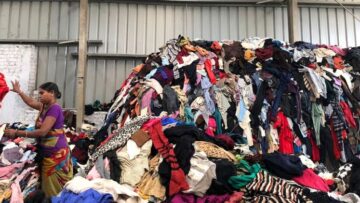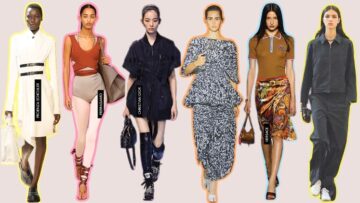According to Ellen MacArthur Foundation – More than US $ 500 billion value is lost every year due to clothing underutilisation and lack of recycling. Fashion brands produce clothing that does not meet demand. There is always a large gap in the supply-demand equation, and there is no doubt that the fashion industry is the only industry that operates on gut feelings, assumptions and a fragmented understanding of the market and customers.
The subjective approach under which the brands work hurt their financials as manual research has strong limitations and so do decisions which are taken based on the fragmented forecasting reports. Given the highly dynamic nature of the fashion industry, data collected and insights gained in the traditional way easily have a 60–70-day gap which makes the products obsolete by the time they hit the market.
Every year, one in four online fashion retailers miss the opportunity to make better margins, better forecasts and the right products because they fail to use data effectively in day-to-day decision-making.
However, with the rise of big data and advanced analytics, it is possible to leverage both new and old data to drastically alter how fashion retailers decide which style to design and produce.
Seizing descriptive analytics to their full potential will encompass determining the best marketing strategies, making much more accurate product recommendations to customers, or making pre-market launch product tests easier.
Data generation is quadrupling speedily. As per Raconteur, 463 exabytes of data are generated every day and the global cloud storage is projected to exceed 200 zettabytes by 2025 (a trillion gigabytes make one zettabyte). Thus, it indicates an enormous amount of information available today and in the future.
Many industries are being reshaped by data analytics and it’s high time the fashion industry starts looking into it too, particularly the fashion retailers since they can take advantage of harnessing the data to improve the planning and forecasting of products.
Data is not a trend, but a tool to help the industry survive and thrive
Retailers now have access to a wealth of information that can be used to make more informed decisions about product mix, pricing, promotions and more. Analytics can help retailers understand what customers want and need, anticipate trends, optimise inventory levels, improve customer service and ultimately drive sales and profits.
Valeriia Povergo, Founder of Dream Dress, a fashion tech start-up that enables fashion consumers to define the right fit without over-ordering says, “Data is critical for retail decision-making, and every solution revolves around it. Dream Dress integrates via API, and the data it generates will assist customers in matching the product search and directing them toward models that suit them. For retailers, it will be extremely beneficial because it will result in receiving the correct order and reducing the number of returns.”
Challenges in effective adoption of data analytics
Earlier, retailers would rely on certain fashion trends remaining popular for many seasons. What makes matters worse is that some retailers are still using outdated methods to try and predict which trends will be popular. As a result, they often end up investing in products that no one ends up buying.
Data is also helping retailers to understand the customer journey better and to create more seamless omnichannel experiences. By understanding how customers interact with different channels, retailers can create a more cohesive customer experience that leads to loyalty and higher sales.
As fashion cycles speed up, retailers don’t have enough time to analyse data and act on it. It’s been more and more difficult to predict when a new trend is going to arise and how much it will impact the retailer’s product performance. Earlier there used to be three seasons, but now the trend is towards seasonless fashion which is on the rise and so is speed. The shoppers expect the market to be flooded as soon as the news comes out. Due to the sudden surge in demand, the fashion cycle speeds up creating smaller lead times. Retailers therefore have to adjust their assortment and marketing strategies to keep merchandise in stock.
Another challenge relates to unpredictable trends and performances. Customer buying patterns sometimes instantly shift either due to the influence of social media, celebrities, or some fashion movement, creating a ‘bullwhip effect’. Due to such high volatility, brands have to analyse the different sources of data by tracking customer consumption and they need to keep a close eye on competitor campaigns, fashion media and industry news which sometimes becomes a tough task along with the faster fashion cycles.
Moreover, the lack of granular performance data also creates a gap, as the retailers need to check the sales of the full body category. Which shirt went along with which trousers and what style of pattern in dresses was a hit becomes challenging for the retailers to predict, especially when competition is stiff. Retailers are still fumbling around and firing shots in the dark to develop a category that is more sellable.
The extracting of insights manually becomes challenging and it gets tougher even more due to the different styles and reports from different data sources. Buyers and planner merchandisers invest a long time on a weekly basis to make sense of the data they have from different sources and vendors, therefore, making the process extremely time-consuming.
Shifting to AI applications delivers tangible results
Big Data analytics can help solve the problem by giving retailers a more accurate picture of what consumers are actually interested in. AI product discovery platforms such as Vi-senze provide analysed data upon which decisions can be made immediately.
Prominent brands such as Amazon and Zalando have introduced personalised search options to adapt offerings for each customer showing that data-driven fashion is not just a fad but a fundamental industry change toward digitisation and a more customer-centric outlook.
Myntra and Ajio are also using visual AI applications to allow customers to search by uploading an image to facilitate product discovery on their platform.
Another way retailers are using AI platforms like Intelligencenode is to track the prices of competitors’ products. This allows them to ensure they are offering their customers the best possible prices for the items they need.
Accessible data usually provides greater efficiency, faster speed and the ability to stay connected with the consumer. With an automated collection of data and insights’ generation, the information is more accurate and easier to be analysed.
For example, the detachable sleeve trend took the market by storm and retailers that coexisted, by mapping through AI applications, invested in the trend compared to retailers that were still confused and struggling with older market trends.
According to Forbes, significant fashion companies have harnessed the power of data to personalise the customer experience and have grown digital sales between 30 to 50 percent.
Benefits of accessible data
In today’s business world, investing in AI applications typically helps companies to structure and sort their data. By leveraging data, companies can gain a deeper understanding of their customers and the trends that are impacting their business. In addition, data can be used to streamline operations and improve decision-making. As such, data is becoming a critical part of the retail landscape.
Few companies have already understood data analytics’ massive role in bringing greater results to retailers. One such example is the AI platform Exponea, which recommends appropriate tags when adding a new product in-store for greater visibility. Another example could be the Massachusetts-based AI-powered start-up Tru-Fit, which helps apparel shoppers by comparing fit data from brands with the closest products and provides personalised size and fit guidance.
The guesswork or the experienced buyer and planner’s instinct is a thing of the past. AI can help solve these problems by providing insights into emerging trends and helping to assess product performance at a granular level.
The status quo
However, the adoption of smart data and the insights that these tools might offer are difficult to be implemented in the fashion industry.
As per McKinsey, one of the major reasons for this is the lack of high-quality data. Therefore, there is still a great deal of untapped potential for a deeper understanding of market trends and the ability to make better business decisions for fashion retailers.

The fashion industry still does not recognise the value of data and views it as a component of core ‘information technology’. Additionally, data extraction in organisations is not done correctly. The industry clearly misses a ‘bridge’ that would help the brands to use and comprehend the significance of data.
Sustalytic, a service platform for fashion retailers, has come forward actively to cement this evident gap by using artificial intelligence (visual technology) to give brands data insights into consumer preferences and help predict client demand at the design stage, thus helping them to take accurate decisions and limit unnecessary overproduction. Companies like these aren’t core IT but they provide a connecting segment that benefits the retailers on multiple levels. The industry needs to tap more such service providers.








